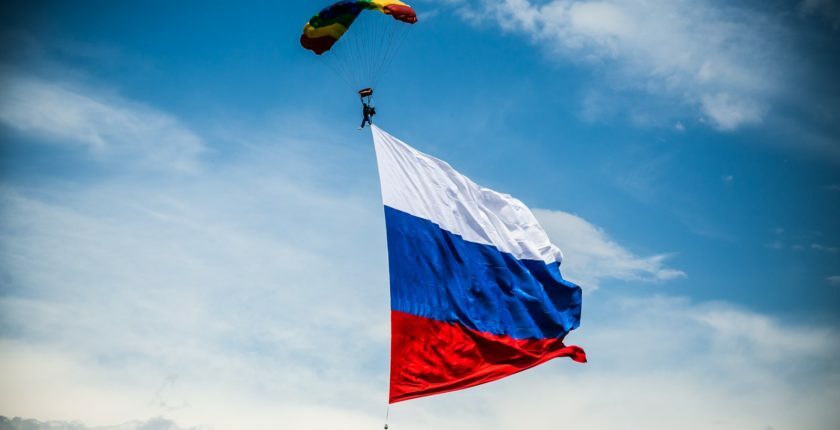
Published: 18.01.2021
Everything you ever wanted to know about the Russian tricolor
Welcome. This week our author Elena will shed some light on the history of the Russian flag as well as share some contemporary facts related to the Russian tricolor.
Introduction
The Russian flag is a white, blue, and red tricolor in a 2:3 ratio. It is divided into three horizontal bars of equal height. The top bar is white, the middle bar is blue, and the bottom bar is red. The current version was formally adopted as the flag of Russia on 11 December 1993, but variants of the tricolor had been in use as the Russian state flag since the collapse of the Soviet Union in 1991.
Welcome. This week our author Elena will shed some light on the history of the Russian flag as well as share some contemporary facts related to the Russian tricolor.
Introduction
The Russian flag is a white, blue, and red tricolor in a 2:3 ratio. It is divided into three horizontal bars of equal height. The top bar is white, the middle bar is blue, and the bottom bar is red. The current version was formally adopted as the flag of Russia on 11 December 1993, but variants of the tricolor had been in use as the Russian state flag since the collapse of the Soviet Union in 1991.

The tricolor was previously used as the flag of the Russian Empire.
It was adopted by Peter the Great in 1696 and remained in use until the Russian Revolution of 1917.Soviet flags in use from 1917 until the dissolution of the Soviet Union in 1991 comprised a hammer and sickle design over a red background. During the Soviet era the Russian Soviet Federative Socialist Republic, as one of the fifteen Soviet republics, used the red Soviet flag with a blue bar along its near side.
The use of the Russian flag was, until recently, restricted to official occasions but, since 2014, Russians have been able to use the flag when they wish to demonstrate their patriotism.
It was adopted by Peter the Great in 1696 and remained in use until the Russian Revolution of 1917.Soviet flags in use from 1917 until the dissolution of the Soviet Union in 1991 comprised a hammer and sickle design over a red background. During the Soviet era the Russian Soviet Federative Socialist Republic, as one of the fifteen Soviet republics, used the red Soviet flag with a blue bar along its near side.
The use of the Russian flag was, until recently, restricted to official occasions but, since 2014, Russians have been able to use the flag when they wish to demonstrate their patriotism.
History of the Russian Flag
Tsar Peter I the Great had ambitious plans to transform Russia into a modern state. Building a Russian navy was part of that program, and he visited the Netherlands to learn about the most advanced shipbuilding concepts and techniques. The flag he chose for merchant ships in 1699 reflected the Dutch red-white-blue tricolor: the Russian flag differed only in having the stripes arranged white-blue-red. The new flag became very popular, so much so that during the 19th century the black-orange-white tricolor that the tsars attempted to impose as a national flag on land completely failed and eventually was abandoned. Just after the beginning of World War I, the flag was modified by the addition of a golden yellow canton bearing the imperial arms, a symbol of solidarity between the ruling dynasty and the Russian people.
Tsar Peter I the Great had ambitious plans to transform Russia into a modern state. Building a Russian navy was part of that program, and he visited the Netherlands to learn about the most advanced shipbuilding concepts and techniques. The flag he chose for merchant ships in 1699 reflected the Dutch red-white-blue tricolor: the Russian flag differed only in having the stripes arranged white-blue-red. The new flag became very popular, so much so that during the 19th century the black-orange-white tricolor that the tsars attempted to impose as a national flag on land completely failed and eventually was abandoned. Just after the beginning of World War I, the flag was modified by the addition of a golden yellow canton bearing the imperial arms, a symbol of solidarity between the ruling dynasty and the Russian people.

In the Soviet era, all Russian flags were based on the Red Banner, which had its roots in the French Revolution and, possibly, even earlier peasant uprisings. After the formation of the Soviet Union, the official state flag contained a gold hammer, sickle, and gold-bordered red star in the upper hoist corner. When the Soviet Union dissolved, its symbols were replaced. The non-Russian territories acquired by tsars and communist leaders became independent, and the Russian Federation that remained readopted the white-blue-red Russian national flag. It became official on August 21, 1991, four months before the formal dissolution of the Soviet Union.

What does the Russian flag mean?
The colors on the Russian flag have no official meaning or symbolism. There are, however, a number of different popular explanations of what the colors on the Russian flag represent. One common interpretation is that they mean:
White – peace and honesty
Blue – vigilance, truth and loyalty, perseverance and justice
Red – hardiness, bravery, strength, and valour
A second interpretation is that the white represents God, the blue represents the Russian emperor, and the red represents the Russian people. A third is that the colors are based on the flag of the Grand Duchy of Moscow and that they represent St George on a white horse, in a blue cape, defeating a red dragon.
The colors on the Russian flag have no official meaning or symbolism. There are, however, a number of different popular explanations of what the colors on the Russian flag represent. One common interpretation is that they mean:
White – peace and honesty
Blue – vigilance, truth and loyalty, perseverance and justice
Red – hardiness, bravery, strength, and valour
A second interpretation is that the white represents God, the blue represents the Russian emperor, and the red represents the Russian people. A third is that the colors are based on the flag of the Grand Duchy of Moscow and that they represent St George on a white horse, in a blue cape, defeating a red dragon.

Pictures of the Russian flag made by Peter the Great
Interesting facts about the Russian flag
1 – The Russian tricolor flag was first introduced in 1696, during the reign of Peter the Great. It was first used as the naval ensign of the Russian fleet, before being adopted as the merchant flag in 1705. Many believe that the Dutch flag of the time was used as the template for the Russian tricolor. This is partly because Peter the Great had strong links to the Netherlands – he had spent some time in the shipyards there during his tour of Europe as a young man (commonly known as Peter the Great’s grand embassy). It is also because David Butler, the captain of Russia’s first naval ship the Oryol, was Dutch. However, there is little hard evidence to support either of these theories.
2 – Back in the day the tricolor was used as Russia’s de facto flag for many years and was incredibly popular among the Russian people – so much so that attempts by Russian Tsars to impose a different flag failed. It was formally adopted as the National flag when Tsar Nicholas II was coronated in 1896.
Russian flag day – 22 August
Russian flag day is celebrated on 22 August every year. It is not an official public holiday, however. The holiday was introduced by President Boris Yeltsin in 1994 to celebrate the defeat of a coup attempt by Soviet hardliners.
1 – The Russian tricolor flag was first introduced in 1696, during the reign of Peter the Great. It was first used as the naval ensign of the Russian fleet, before being adopted as the merchant flag in 1705. Many believe that the Dutch flag of the time was used as the template for the Russian tricolor. This is partly because Peter the Great had strong links to the Netherlands – he had spent some time in the shipyards there during his tour of Europe as a young man (commonly known as Peter the Great’s grand embassy). It is also because David Butler, the captain of Russia’s first naval ship the Oryol, was Dutch. However, there is little hard evidence to support either of these theories.
2 – Back in the day the tricolor was used as Russia’s de facto flag for many years and was incredibly popular among the Russian people – so much so that attempts by Russian Tsars to impose a different flag failed. It was formally adopted as the National flag when Tsar Nicholas II was coronated in 1896.
Russian flag day – 22 August
Russian flag day is celebrated on 22 August every year. It is not an official public holiday, however. The holiday was introduced by President Boris Yeltsin in 1994 to celebrate the defeat of a coup attempt by Soviet hardliners.
Would you like to brush up your Russian or make your New Year resolution (learning Russian) come true? No matter what you goal and level of Russian is, we will help you to make your dream come true.

Elena Killiakova
SIMILAR POSTS
Subscribe for Enjoy Russian news
DO YOU WANT TO RECEIVE THE BEST ARTICLES FROM ENJOYRUSSIAN ONCE A WEEK?
Contact us
We will select a Russian language course for your goals
Categories
Our Courses
We use cookies to provide the best site experience.
Ok, don't show again








